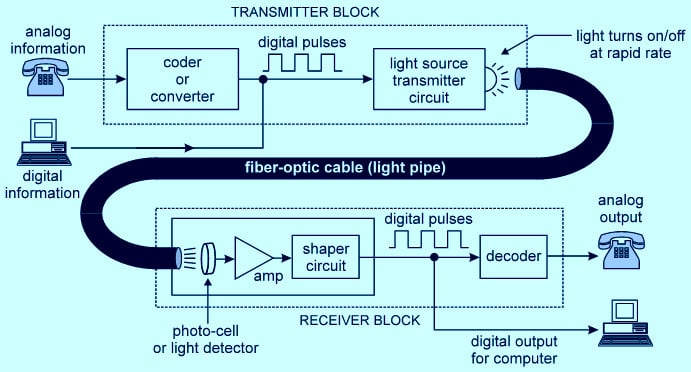Fibre Optic Communication
- By Harsha Sinha
- Batch(2k19), Deptt. of Chemical Engg.
- BIT Sindri, Dhanbad
As we all are aware of the importance of communication in this decade and in the upcoming years where we can connect with anyone, wherever and whenever we want to in the global village's digital era. We need some powerful medium.
INTRODUCTION
Fibre-optic communication is one such important advancement. This method is used to transmit information from one place to the other by sending pulses of infrared light through an optical fibre. The light acts as a carrier wave which is modulated to carry the required information. Since we want to send information to longer distances where the bandwidth is higher, fibre-optic is much precise and efficient as compared to electrical cables. This type of communication can transmit voice, video, and telemetry through local area networks or across long distance.
Fibre
optic transmission system: -
Transmitter (light source)
Fibre optic cable
Optical repeater
Receiver (Detector)

1) Fibre
optic transmitter
We are having a variety of devices for this purpose but the
most common emitter device is the light emitting diodes. The main benefit of
LEDs is that these are cheaper, which makes it ideal for low cost applications
where only short runs are needed. However, they have a number of drawbacks. Therefore,
the LEDs are mostly used for local area network applications where the data rate
lies under 80Mb/s, that too within few kilometres area. For longer distances
and for higher data rates Laser is used instead of LEDs. Since they provide
better outputs, they are quite expensive as compared to the LEDs.
Laser diode provides an effective method for transferring data through the optical signal by directly modulating it. This is done by controlling the current flow. For much higher data rate, the lasers are made to run as a constant continuous wave.
2) Fibre
optic cable
The optic cable basically consists of three parts, first being core surrounded by the second layer, cladding and is completely covered by a protective outer coating. Operation of the cables takes place as cladding has a lower refractive index as compared to the core. Hence the light passing through the core has to undergo TIR (Total Internal Reflection).
3) Repeaters
and amplifiers
Although cable can be used to transfer signal to a greater distance,
but after certain limit signals start getting distorted, hence to overcome this
and to transmit the signals efficiently we need repeaters and amplifiers.
These amplifiers directly amplify the optical signal without converting it into an electrical format. The fibre optic cable that is used in the amplifiers is doped with Erbium, a rare earth mineral.
4) Receivers
After the transmitting process is done, the signal is
converted back to the electrical format with the help of receivers.
The main component of the receiver is a photo-detector which
is normally a semiconductor device with a p-n junction, or an avalanche
photo-diode.
Because of its additional features such as lower attenuation and interference, it is more efficient than the copper wire system for longer distances. Initially due to high production cost, it was not a viable option, but gradually the prices of fibre optic communications have dropped and hence it is finding some applications these days in the city itself, but still it would take some time to flourish completely.
Apart from the telecommunication services, the fibre optic cable has few more applications such as: -
1) Imaging tool
2) Lasers
3) Sensor to measure pressure and temperature
4) Hydrophones for seismic waves
5) SONAR
Because of its vast application, no sooner these cables would take over the market for both long and short data transmission applications.

ConversionConversion EmoticonEmoticon